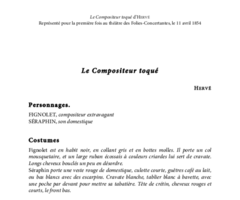Le Compositeur toqué
Bouffonnerie musicale en un acte.
“The Compositeur toqué rather than Don Quichotte et Sancho Pança [Hervé’s first work, premiered in 1847] should be seen as the first manifestation of operetta.” (Francisque Sarcey, 1881). Although the (somewhat pointless) debate positing Hervé as the father of operetta continues, Le Compositeur toqué was a seminal work both for its composer and for the burgeoning genre. Written, composed and performed by Hervé, this “bouffonnerie musicale en un acte” was staged in April 1854 at the theatre run by Hervé, who had become its director a few months previously: the Folies-Concertantes. Although the work’s title soon became the official nickname of the composer-cum-performer, the term “toqué” was not so much a self-portrait as a parody of Romantic musicians suffering from delusions of grandeur. Consequently, it is hard not to think of Hector Berlioz or Félicien David when Fignolet introduces his symphony La Prise de Gigomar par les Intrus which is “in the great E sharp major” and has “ninety-nine firecrackers in the key signature”. With the help of his servant Séraphin, Fignolet describes his composition during the course of the operetta’s six numbers, with the liberal use of plays on words, puns and lessons in the stress patterns of the French language. Le Compositeur toqué was an immediate success, as can be seen by its revival in the December of 1854, but Hervé’s imprisonment in 1856 due to a sex scandal put a halt to performances. When the composer returned to the limelight, in the late 1860’s, the time for a revival had passed: audiences were now favouring larger-scale operettas.

